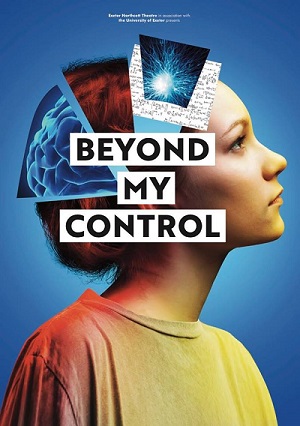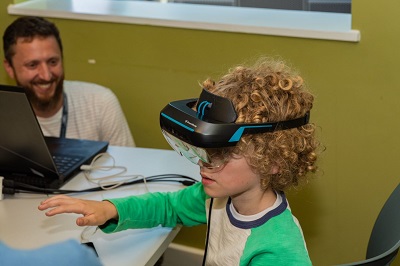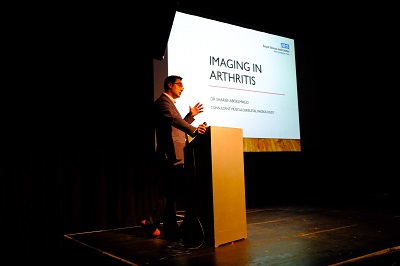Case studies
Take a look below at our case studies of public engagement activities.
Beyond My Control is a unique piece of theatre created in collaboration between Professor John Terry and Paul Jepson (a leading UK theatre director), alongside the Exeter Northcott Theatre and people with lived experience of epilepsy.
Beyond My Control uses a combination of improvisation techniques, verbatim testimony of people with epilepsy and projected images of mathematics and brain networks to explore the challenges of living with epilepsy, and the stigma that people experience, and how our mathematical research offers new understanding of the mechanisms within the brain which cause susceptibility to seizures and therefore the condition epilepsy.

As part of his seed corn project, Francesco Tamagnini created a video to open up discussions around the use of animals in health research. The filmed conversation included volunteers from the Alzheimer’s Society Research network, three University of Exeter researchers, and the lay member of an Animal Welfare and Ethics Review Board (who is also member of TREE’s MAGPIE). The video can be viewed below and found on the Animal Nexus website, and has also led to the publication of a paper on this activity.
In 2017, Dr Eder Zavala, MRC Research Fellow, hosted a workshop to build non-academic collaborations in neuroendocrine research, including with patient groups and charities. The event was funded by the University of Exeter’s Engaged Research Exploratory Award. The purpose of the workshop was twofold. Firstly, we wished to communicate to our patients how hormone levels change in time, why considering these changes is key to understanding (and improving) current drug therapies, and what our mathematic oriented research has to do with all this. Secondly, we wanted to hear directly from people living with endocrine conditions about the most pressing issues associated with their diagnosis, early vs. current drug therapy, their side effects, emergency care, and in general, priority areas that from their perspective need the most attention to improve their quality of life. Furthermore, we offered them a vision of what’s to come in future research projects, and invited them to provide feedback and consultation on the development of such projects (instead of solely participating as study subjects).
On 21 June 2019, the Living Systems Institute (LSI) held its' first Open Night, an evening dedicated to showcasing the pioneering research taking place at the LSI. The evening comprised of talks, interactive demonstrations, workshops and games! Several TREE researchers showcased their work in an engaging way to the public.

TREE Fellow Dr Ben Sherlock hosted a public science lecture on 'Imaging in Arthritis' on 23 July 2019 at the Exeter Phoenix. As part of a GW4 initiative, Ben and colleagues have been creating a new community of scientists, clinicians and patients to drive the next generation of life changing advances in joint disease diagnosis and treatment. As part of the official launch, the Imaging Arthritis Consortium hosted a public science lecture by RD&E consultant radiologist Dr Sharief Aboelmagd, which was attended by 184 people. The lecture provided an insight into the tools and technologies used by radiologists to diagnose joint disease, and gave an overview of the cutting edge research that will revolutionise diagnosis and treatment of joint disease in the coming decades.

In December 2018, Dr Yolanda Hill and Dr Chris Marcotte organised a public lecture on 6th December entitled "The beat goes on...understanding the heartbeat using maths and computers". Professor Richard Clayton from the University of Sheffield talked about his work using mathematical and computational models of the heart to study its structure and function, both in health and disease.
QBME researchers regularly showcase their research at various outreach events, including:
- Pint of Science: In 2019, Dr Margaritis Voliotis presented his work on brain rhythms controlling reproduction, and Professor John Terry and MAGPIE Simon hosted a quiz on epilepsy!
- Sidmouth Science Festival: The festival is a family-friendly event which features fun and thought-provoking events including talks and workshops… and it’s all about science! In 2018, researchers brought along varied activities, including a brain model, a cell segmentation exercise, a heart model and fibrillation simulation, and finally a headset which displays brain activity!
Several patient focus groups have been delivered through the seed corn projects, with the aim of gathering feedback on the seed corn project from the patient or carer perspective, and input on future research ideas. Patient groups have included, amongst others: people with lived experience of depression, carers for people with dementia and people with osteoarthritis.
In 2018, TREE Fellow Dr Ben Sherlock hosted a workshop with osteoarthritis patients. The aim of this workshop was to introduce his new research project, hear the patient's stories of diagnosis and treatment, and gather feedback on how the research could be developed.
Patient and Public Involvement (PPI) is an integral part of Associate Professor Karen Knapp’s seed corn project (CSPINE, Round 6). Two workshops were delivered. The first aimed to hear patient experiences of neck injury diagnosis, treatment and potential improvements, and to gather patient ideas around the concept of computer software assisting diagnosis in the emergency setting. Further, participants suggested how the CSPINE software might be used to support diagnosis of neck injuries in developing countries. The second workshop aimed to update the group on how the seed corn project was progressing, and to discuss further reflections on the concept of computers assisting diagnosis in the emergency setting.
Nanomedicine
Dr Charlie Jeynes
This short animation, part funded by Exeter's TREE ‘seedcorn’ award, introduces ’nanoparticles’ as potential agents for use in the treatment of various diseases like cancer. Nanoparticles can convert electromagnetic energy into heat, for instance from near-infra-red light, making them attractive candidates for ’thermal’ therapies. This animation shows how this could work and illustrates some future applications of nanoparticles in medicine. Working with Exeter’s Physics department, LSI’s Charlie Jeynes has used a biophysical modelling approach to test the feasibility of potential treatments in silico. More details can be found in their recent publication (Jeynes et al. (2019) Biomolecules doi.org/10.3390/biom9080343) and press release: https://www.exeter.ac.uk/news/featurednews/title_723809_en.html)
Safer drugs for symptoms of Alzheimer's disease
As part of his seed corn project, Dr Byron Creese from the University of Exeter Medical School created the below video to explain his work on finding safer drugs for symptoms of Alzheimer's disease. This video provides a short introduction to some of the problems associated with treatments for agitation and psychosis in dementia. It also contains a broad outline of what Byron and colleagues are doing in order to understand more about why some treatments are harmful.
Cancer detection and therapy with light and nano-gold
As part of her seed corn project, Dr Priyanka Dey produced the below video explaining her research using light and nano-gold in the context of cancer detection and therapy.
The Domino Effect in Seizure Onset in Epilepsy
Check out this video where Dr Jen Creaser explains seizure onset in epilepsy as a cascade of dominos.
